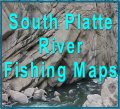Banana Belt Trout: The Arkansas
by Al Marlowe
Mid-winter is not the time when most anglers think of fishing open streams other than tailwaters. Colorado's mountains, however, create interesting micro-climates. When high peaks are buried in snow, valleys on the lea side are often banana belts – areas of warmer than expected weather. The Arkansas River Valley through Salida is one such anomaly. At a time when most high country waters are locked in ice, the Arkansas is usually open, even though it's not a tailwater. In milder winters, the banks may even be free of snow.
When conditions are right for a frequently occurring midge hatch, fly fishermen can enjoy dry-fly action. Combining that with a pleasant February or March day offers anglers the makings of a break from cold and snow found in much of the rest of the state.
The Arkansas River is one of Colorado's major rivers. It heads near Leadville and flows south past the towns of Buena Vista and Salida. It then turns east, through Royal Gorge (one of the deepest canyons in the state) passing through Canon City and Pueblo, having traveled 150 miles before heading out across the Colorado Plains. The portion of the Arkansas that flows through Brown's Canyon and the Royal Gorge is famous for rafting, and in fact is the most rafted river in the country. There are heaps of huge rapids, with forbidding names like "Caretaker" and "White Wash". This river is also famous for the Mother's Day Caddis Hatch, when anglers descend on the miles and miles of river looking for hungry browns gobbling up the caddis.
The well-known hatch isn't the only time to fish the river, though. Last year when Karen Christopherson, who operates the coloradofishing.net web site, asked if I wanted to go to the Arkansas with her, my first thought was that I had little interest in fishing there. Then she said it would be on private water. This piqued my interest as I had previously fished only public stretches. When she said it would be with a guide my interest level increased exponentially. We would fish more than a half-mile of private water near Wellsville, east of Salida. It's not every day that I get invited to fish private water with a guide who knows the water very well.
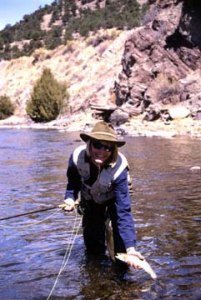 |
| Karen Christopherson shows off a typical Arkansas River brown |
My previous impressions of the river had been that it's a long way to go from my Evergreen home to catch a few small browns. I soon changed my mind. Angling guide Jim Partin said of the Arkansas, "It's not a place to catch large fish, although the river does have trout in the 17-inch class. This is a place to catch a lot of fish." Partin says that anglers who know the river can easily enjoy 40-fish days.
Colorado Division of Wildlife fisheries manager Eddie Kochman said, "I grew up in Salida and a few decades ago the river did have some big browns." He added that the Division at that time stocked large numbers of small rainbows, which he thinks became brown trout gourmet meals, the reason they grew big. Browns are also reproducing in the river, the only trout to do so with much success here.
The Arkansas has been quite abused in the past century. Kochman remembers that raw sewage was dumped in the river. Heavy metals from old abandoned mines and natural sources, along with whirling disease have made the stream inhospitable for trout, particularly rainbows. Decreasing the amount of heavy metal pollution has benefited the browns, though. According to CDOW, the trout population in the Arkansas is 90 percent self-reproducing brown trout and 10 percent Colorado River rainbows, which are introduced as fingerlings. The river holds about 2,000 fish per mile on the average. Few rainbow trout are caught here now, but they are on average larger than the browns. Most browns run 10 to 14 inches, and while not large fish, they are in good condition. They're feisty and full of fight.
Partin says that the Arkansas is a large river by Colorado standards. He suggests using a fly rod of 5- or 6-weight, 8 1/2 to 9-feet length. Leaders should be eight to 10 feet long tapering down to 3x to as fine as 6x for midge adults and emergers or larvae. Neoprene chest waders are advised for the cold water temperatures and felt-soled or other slip-resistant boots for the slick bottom.
Although it won't be hot in February, temperatures in the afternoon can be pleasant. Dress in layers for warmth and to easily adjust for weather changes. Polarized sunglasses are suggested to make it easier to see fish. Amber lenses work well on overcast days. Even in winter sun screen is advisable due to glare off the water.
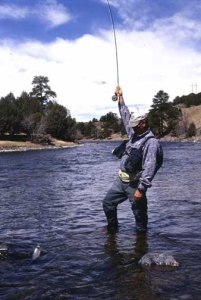 |
| Jim Partin demonstrates how it's done |
Don Puterbaugh, a Salida resident and regular on the Arkansas has recommended patterns for winter fishing include Brassies and Pheasanttails (beadheads) in sizes 18 - 20, and Beadhead Blackmagic in 20 - 22. For dry flies, Puterbaugh likes No. 22 midge paterns, and tiny Elk Hair Caddis in No. 18 - 22.
Other anglers suggest the Midge Pupa (Black, Brown, Cream, Grey, Red) No.16-22, Brassie No.16-20, RS-2 No.18-22, Griffith's Gnat No.16-22, Midge Dry (Adams, Olive, PMD, Black) No.18-22, and a No.16-18 Miracle Nymph. The Arkansas also has large stoneflies so nymph patterns should be included in the angler's fly box.
Later in winter and early spring when the caddis begin to get active the Elk Hair Caddis is one of the preferred dry fly patterns. When caddis and Baetis are on the water Partin likes to use a No. 12 or 14 Elk Hair Caddis as a strike indicator, and a tungsten bead-head nymph on a dropper. He says that tungsten beads are denser than brass and get down to the fish a little faster.
Partin says anglers should clear the water in front – that is, work outward from shore by casting quartering upstream, letting the fly-nymph setup drift over likely holding places. After a half-dozen casts, wade into the water and work the currents a little further out. There's no need for extremely long casts. Continue this way working upstream, hitting the most likely runs and riffles.
Other open water in winter on the Arkansas is available below Pueblo Dam. Xavier Duran, owner of Xie's Fly Fishing Specialties in Pueblo says that November through March is the best time to fish here. The water is low and clear, and overcast days often bring out a Baetis hatch. The first two miles below the dam have browns and rainbows in the 16-inch class that will rise to a Blue-winged Olive. The section also has big browns that can be taken on large streamers.
Marty Bartholomew, author of Flyfisher's Guide To Colorado, advises using a 10-foot leader tapered to 6X, with a No. 18 - 22 Olive Comparadun for the Baetis hatch. When midges are coming off, the same rig with a Griffith's Gnat is Bartholomew's fly of choice. For subsurface feeders he recommends a Black Midge or chocolate Gold Ribbed Hare's Ear, either in sizes 18 to 24. A caddis nymph in light olive, tan, or green in larger sizes work, too.
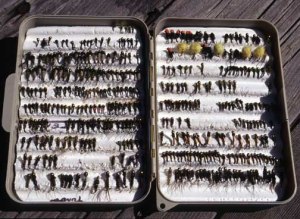 |
| Jim Partin's Arkansas River fly box. He likes the tungsten bead head nymphs as a dropper under and Elk Hair Caddis strike indicator |
Winter flows here are variable but run 100 to 300 cfs on average, the most productive rate for anglers. Duran says that water level and clarity determine how well the trout respond to emergering insects. He also says that with flows being variable, the water may be off-color for a couple of days. As soon as the water clears, the fish resume active feeding.
Evergreen angler Kip Wilson says that big trout in this section also go for lures. He has had good luck with Rapalas here.
An advantage of fishing the Arkansas in winter is the absence of rafters that are so numerous in summer. Anglers are often fewer then, too. When the Mother's Day caddis hatch is on beginning in late April and running through much of May, fly fishermen can be nearly as numerous as the bugs in the air and on the water. Well, not really, but finding unused water then can be both challenging and frustrating.
This isn't a problem in winter. And while forty-fish days may not be the norm in February, the right fly in the right place will produce action. Just try to pick a day when a snow storm won't interfere with getting there.
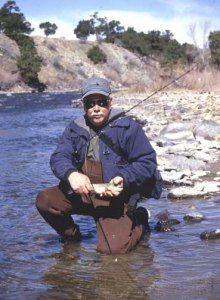 |
| Author with a 14-inch Arkansas River brown |
Copyright © 2000-2011 by Al Marlowe. No reproduction, linking, or copying without permission.
For Your Information
Read a story about the Mother's Day caddis hatch on the Arkansas
Guided fishing on private water, wade fishing or float trips:
- Colorado Fly Fishing Guides in Leadville http://coloradoflyfishingguides.com
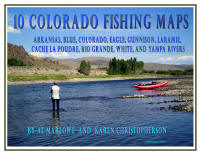 Click here to buy digital downloadable Ten Colorado Fishing Maps which includes the
Arkansas River.
Click here to buy digital downloadable Ten Colorado Fishing Maps which includes the
Arkansas River.

